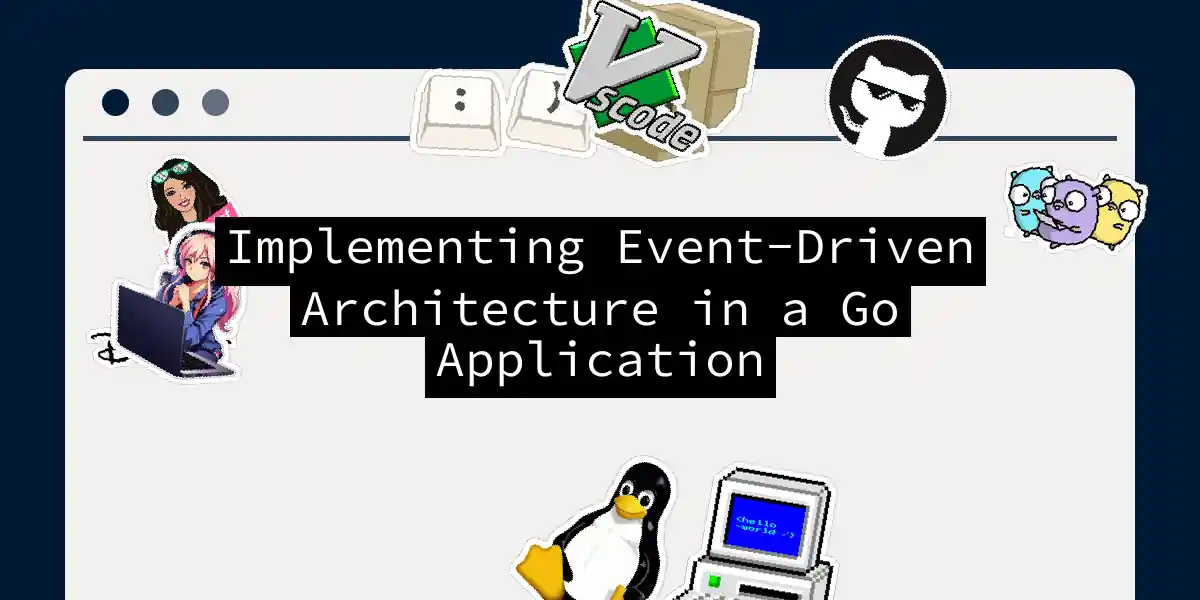Introduction to Event-Driven Architecture
In the ever-evolving landscape of software development, event-driven architecture (EDA) has emerged as a powerful paradigm for building scalable, resilient, and highly adaptable systems. At its core, EDA revolves around the production, detection, and consumption of events, which are significant changes in state or important milestones in a system. This approach is particularly well-suited for applications that require real-time processing, decoupled microservices, and the ability to handle failures gracefully.
Why Event-Driven Architecture?
Before diving into the implementation details, it’s crucial to understand why EDA is a compelling choice:
- Scalability: EDA allows different components of your system to scale independently, which is essential for handling varying workloads.
- Decoupling: Services in an EDA system are loosely coupled, meaning changes in one service do not directly affect others, enhancing system reliability and maintainability.
- Real-Time Processing: EDA enables real-time processing and notification, which is vital for applications that require immediate responses.
Key Components of Event-Driven Architecture
Events
Events are the heart of EDA. They represent significant state changes or actions within the system. Here are some key aspects of events:
- Event Structure: Events typically include a payload (the data associated with the event) and headers (metadata such as event type, timestamp, and correlation ID).
- Event Versioning: To ensure backward compatibility and support for schema evolution, events should be versioned.
Event Producers
These are the components that generate events. For example, in a payment processing system, the payment service could be an event producer when it generates a “payment confirmed” event.
Event Consumers
These components react to events. In the same payment processing system, the notification service could be an event consumer that sends a confirmation email when it receives the “payment confirmed” event.
Event Broker
The event broker is the messaging system that handles the publication and subscription of events. Popular choices include Apache Kafka, RabbitMQ, NATS, and Solace PubSub+.
Implementing EDA in Go
Setting Up the Environment
To start building an event-driven application in Go, you need to set up your environment with the necessary tools and libraries.
# Install Go
sudo apt-get install golang-go
# Install NATS (as an example event broker)
sudo apt-get install nats-server
# Start NATS server
nats-server
Using Watermill for Event Handling
Watermill is a Go library that simplifies building event-driven applications by providing a high-level event bus.
package main
import (
"context"
"fmt"
"log"
"github.com/ThreeDotsLabs/watermill"
"github.com/ThreeDotsLabs/watermill/message"
"github.com/ThreeDotsLabs/watermill/pubsub/gochannel"
)
func main() {
// Create a new Go Channel publisher
publisher, err := gochannel.NewPublisher(gochannel.Config{})
if err != nil {
log.Fatal(err)
}
// Create a new Go Channel subscriber
subscriber, err := gochannel.NewSubscriber(gochannel.Config{})
if err != nil {
log.Fatal(err)
}
// Publish an event
msg := message.NewMessage(watermill.NewUUID(), []byte("Hello, World"))
if err := publisher.Publish("my_topic", msg); err != nil {
log.Fatal(err)
}
// Subscribe to the topic and handle the event
ctx := context.Background()
if err := subscriber.Subscribe(ctx, "my_topic", func(msg *message.Message) error {
fmt.Println(string(msg.Payload))
return nil
}); err != nil {
log.Fatal(err)
}
}
Using Encore for Pub/Sub Messaging
Encore is a platform that simplifies building event-driven applications with Go by providing a robust Pub/Sub messaging system.
package main
import (
"context"
"fmt"
"encore.dev/beta/auth"
"encore.dev/beta/pubsub"
)
type Site struct {
ID string `json:"id"`
Name string `json:"name"`
}
func AddSite(ctx context.Context, site Site) error {
// Publish the event
pubsub.Publish(ctx, "site_added", site)
return nil
}
func MonitorSiteAdded(ctx context.Context, msg *pubsub.Message) error {
site := Site{}
if err := msg.Unmarshal(&site); err != nil {
return err
}
fmt.Printf("Site added: %s\n", site.Name)
return nil
}
Sequence Diagram for Pub/Sub Messaging
Handling Errors and Ensuring Resilience
Error handling is crucial in EDA systems to ensure resilience and prevent system failures.
Retry Mechanism
Implementing a retry mechanism can help handle temporary errors.
package main
import (
"context"
"fmt"
"time"
"github.com/ThreeDotsLabs/watermill"
"github.com/ThreeDotsLabs/watermill/message"
)
func retryHandler(ctx context.Context, msg *message.Message) error {
maxRetries := 3
retryDelay := 500 * time.Millisecond
for i := 0; i < maxRetries; i++ {
if err := processMessage(ctx, msg); err != nil {
fmt.Printf("Error processing message: %v. Retrying...\n", err)
time.Sleep(retryDelay)
} else {
return nil
}
}
return fmt.Errorf("failed after %d retries", maxRetries)
}
func processMessage(ctx context.Context, msg *message.Message) error {
// Simulate an error
return fmt.Errorf("simulated error")
}
Idempotent Event Handlers
To prevent duplicate processing, event handlers should be idempotent.
package main
import (
"context"
"fmt"
"github.com/ThreeDotsLabs/watermill"
"github.com/ThreeDotsLabs/watermill/message"
)
func idempotentHandler(ctx context.Context, msg *message.Message) error {
// Check if the event has already been processed
if alreadyProcessed(msg) {
return nil
}
// Process the event
if err := processMessage(ctx, msg); err != nil {
return err
}
// Mark the event as processed
markProcessed(msg)
return nil
}
func alreadyProcessed(msg *message.Message) bool {
// Check if the event has already been processed
// This could involve checking a database or cache
return false
}
func markProcessed(msg *message.Message) {
// Mark the event as processed
// This could involve updating a database or cache
}
Testing and Deployment
Component Testing
To ensure system reliability, it’s essential to write component tests that isolate dependencies and improve testability.
package main
import (
"context"
"testing"
"github.com/ThreeDotsLabs/watermill"
"github.com/ThreeDotsLabs/watermill/message"
)
func TestEventHandler(t *testing.T) {
// Create a mock message
msg := message.NewMessage(watermill.NewUUID(), []byte("Hello, World"))
// Call the event handler
if err := eventHandler(context.Background(), msg); err != nil {
t.Errorf("expected nil, got %v", err)
}
}
Deployment with Encore
Encore provides a seamless way to deploy your event-driven application to the cloud.
Conclusion
Implementing event-driven architecture in a Go application offers numerous benefits, including scalability, decoupling, and real-time processing. By leveraging tools like Watermill and Encore, you can build robust and resilient systems that handle errors gracefully and scale efficiently. Remember, the key to a successful EDA system lies in careful event design, robust error handling, and thorough testing.
As you embark on this journey, keep in mind that EDA is not just about technology; it’s about creating systems that are adaptable, reliable, and capable of handling the complexities of modern software development. Happy coding
